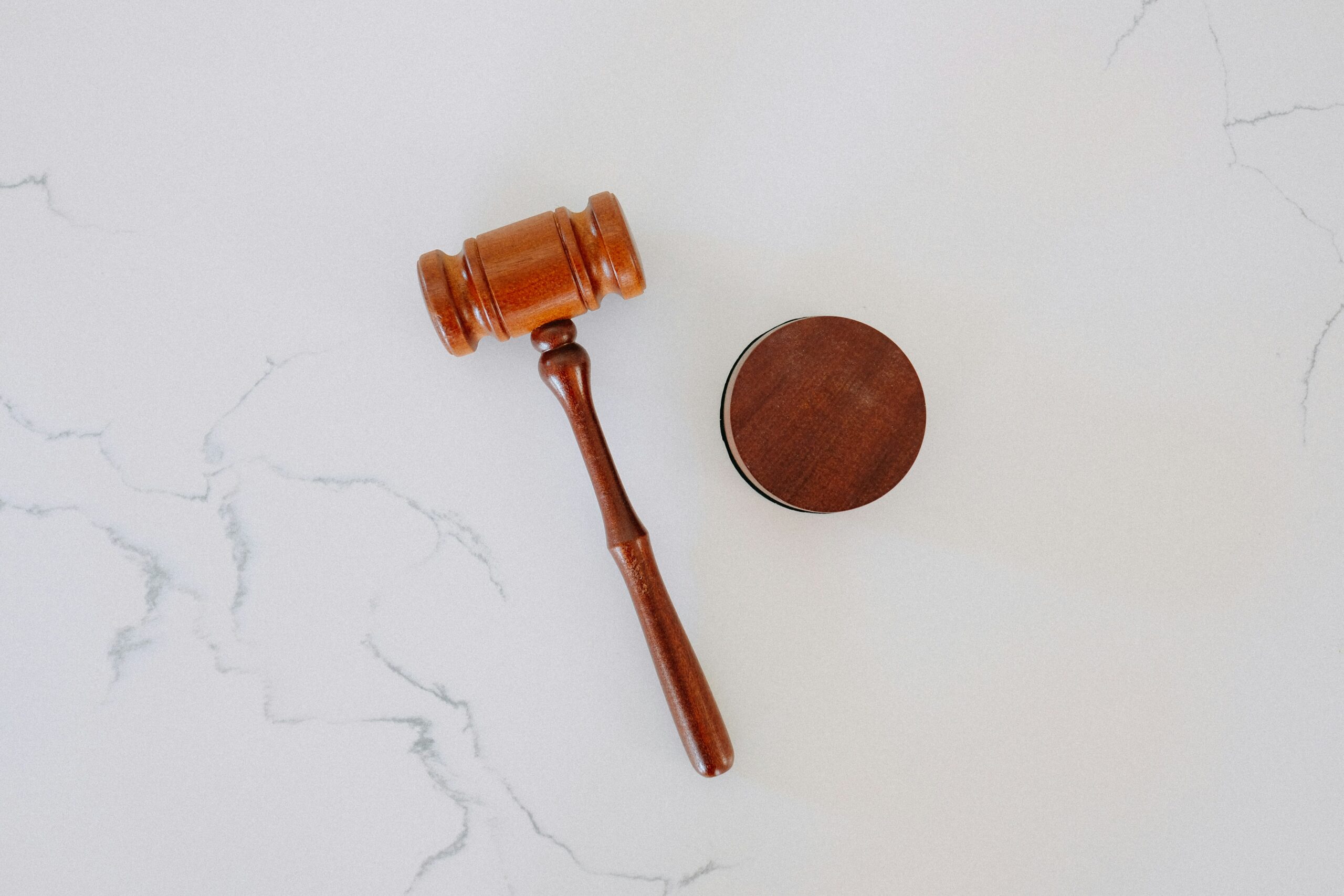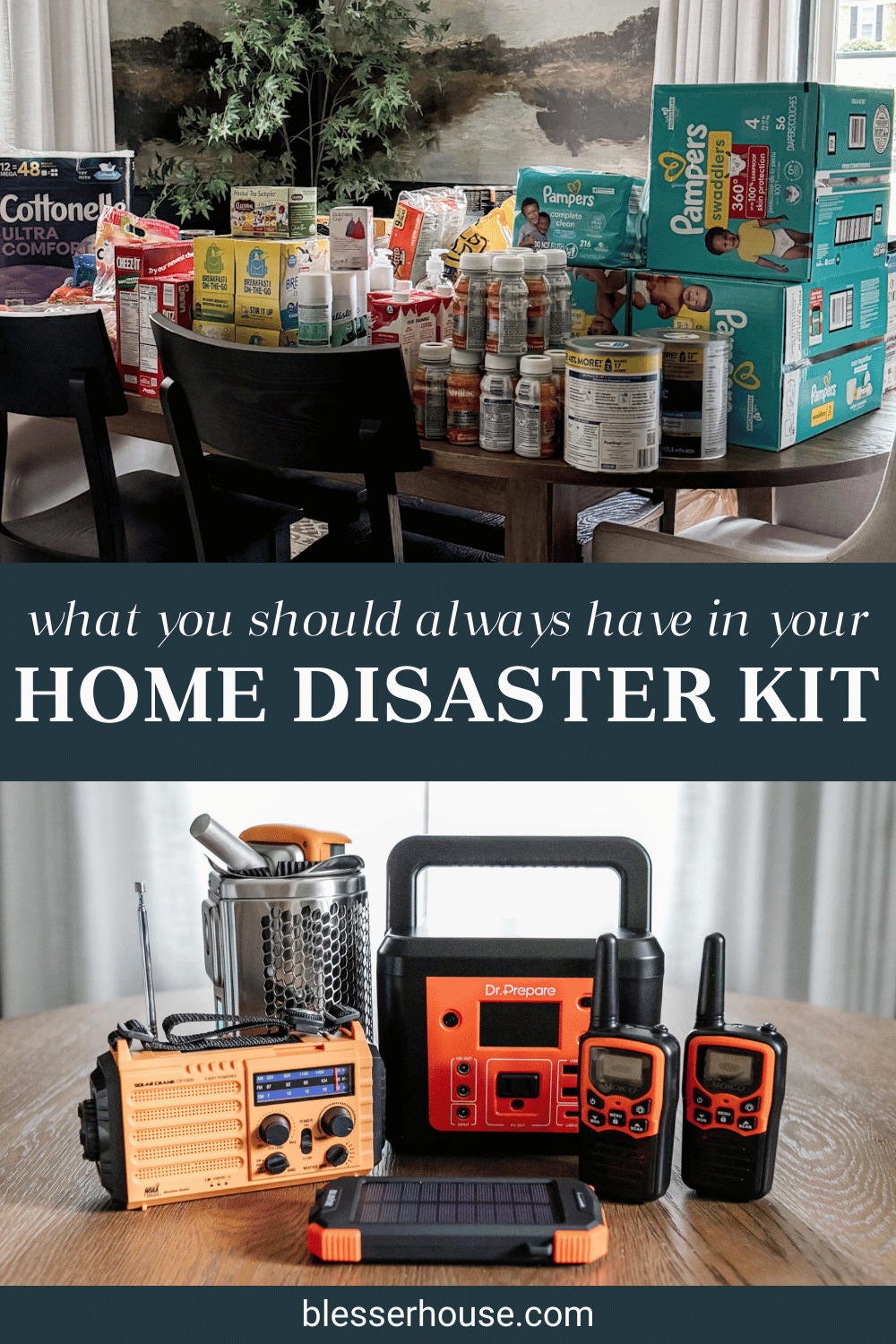
With everything that has happened here in the Carolinas over the past few days, this post felt really important to share.
It’s not something I’ve EVER talked about with you guys, but Robert and I have made it a priority for years to keep our home disaster kit stocked. Because you just never know when an emergency will strike.
As we were loading up some supplies yesterday to drop off in Western North Carolina, I thought, “We need to share this information. People NEED to know how to prepare for these things.”
What to do before disaster strikes
Robert was part of the Hurricane Katrina relief units when he was in the Marine Corps; he trained in all kinds of survival scenarios in those USMC years. It has influenced a lot about how he and I have prepared our household for natural disasters.
If you want to be really prepared in case of an emergency, doing these steps now will help:
- Take a first aid class. You can take a first aid course online with the Red Cross. It only takes 2 hours. (I did this before my oldest was born, and I’m so glad I did.)
- Make an emergency plan with your family. Talk to your kids in-depth about it.
- Check community events near you for kids’ safety training with local firefighters.
- Gather and inventory all supplies before a storm is even in the forecast. Storms make supplies scarce and scarcity can cause panic; don’t contribute to that panic by hoarding supplies when they’re most needed. You want to compile your disaster kit way before you need it.
The four things you should always prioritize in a disaster situation are protection, rescue, water, and food.
*Our emergency kit is a little lighter than usual in this photo since we’ve used some of its resources for this storm.
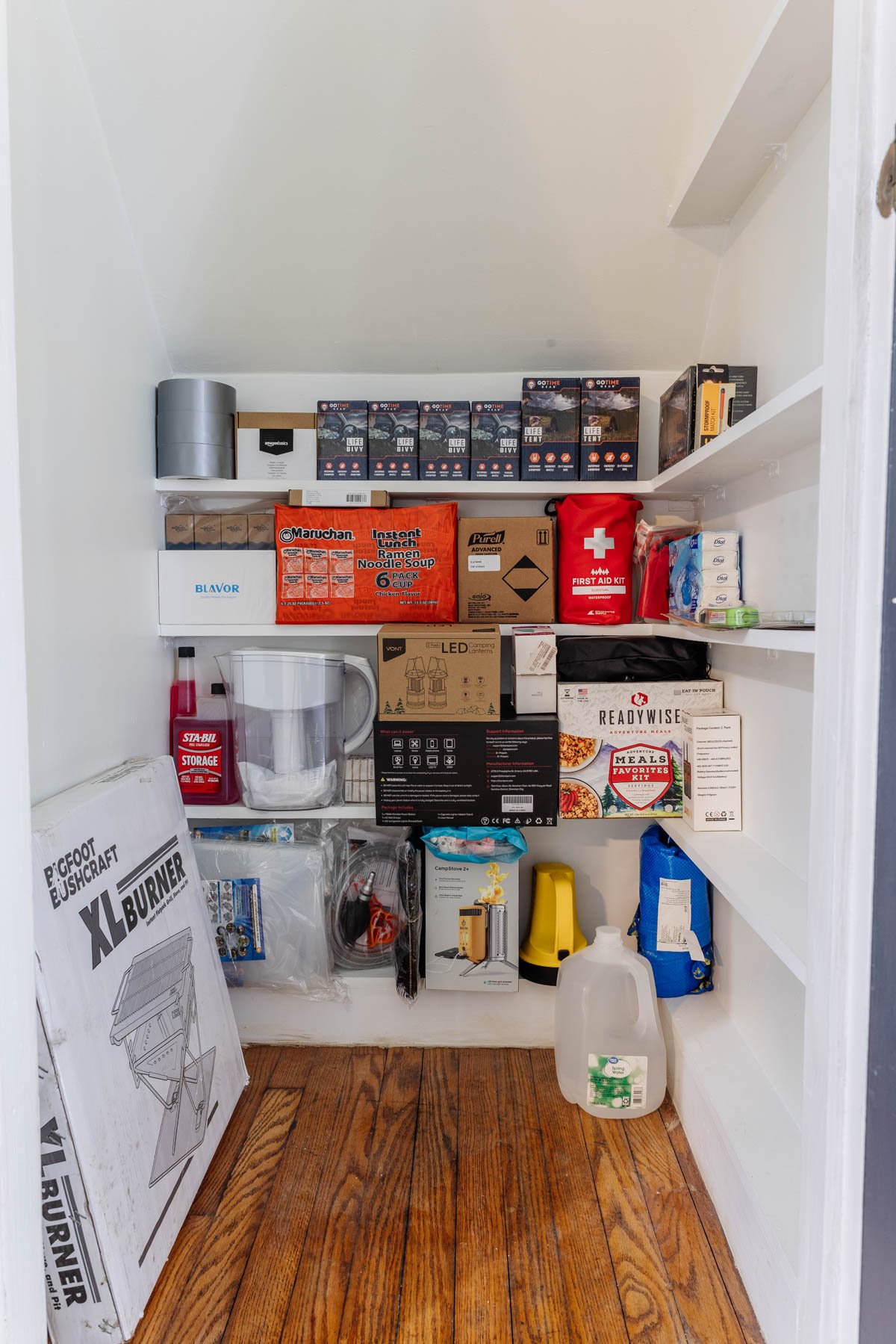
I have included affiliate links in this blog post, but we will be donating all affiliate commission earned from this post this week to Hurricane Helene relief at no cost to you. Full disclosure
Kit Storage
These are the items below that we recommend you keep in your stash to help. Plan to store these items in a cool, dry space like a closet or a cabinet.
Or best of all, keep all of your items inside of a waterproof storage bin like this Rubbermaid ActionPacker Bin. We have our items accessible in a closet, but we keep our bin nearby so we can toss everything in it and run if we have to in a moment’s notice.
When we’re under a tornado watch, we stock the bin. When a tornado warning occurs, we grab the bin and shelter in place in our downstairs, windowless central bathroom.
We keep the most essential items in a waterproof backpack, so if that’s the only item we have time to grab while we’re running from a dangerous situation, we still have the basics to get by with our go-bag.
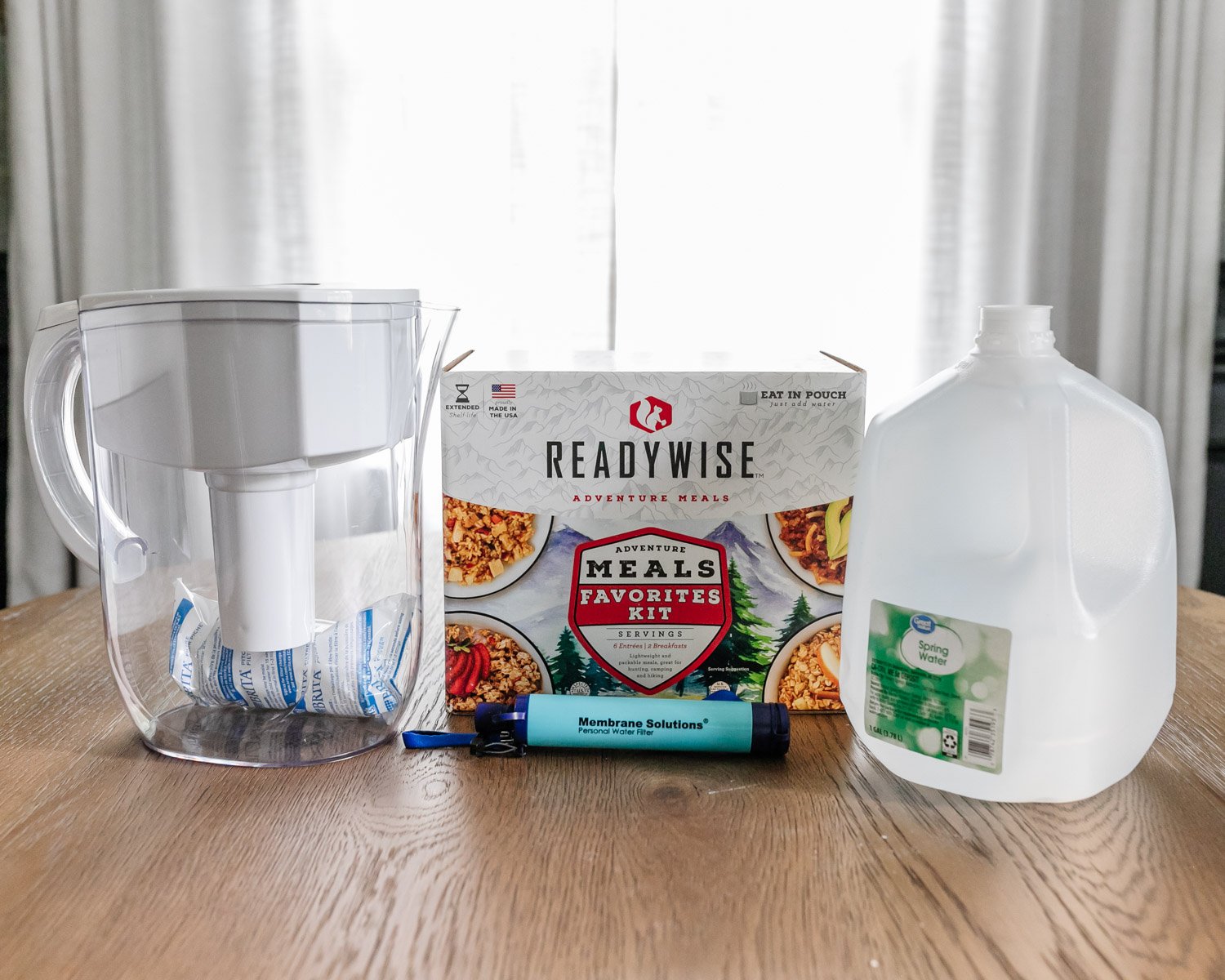
Food and Water
We have all of these items in our stash and can’t recommend them enough. FEMA recommends that you store a 3-day supply of water – 1 gallon per person per day in your household.
Even if you don’t have any special kind of water storage system, filling pitchers and Rubbermaid containers with water before a storm hits can make a big difference in your survival.
Water Storage Cube – Fill up these water jugs before a hurricane hits. Even though store bought bottled water is scarce in our area right now, we were able to purify our own water and fill these jugs to send to Western North Carolina. A 5.3 gallon jug will sustain 1 person with drinking water for 5 days.
AquaPod Kit – It’s really important to fill this water storage bag in your bathtub before a storm. (We usually have 24-48 hours notice before a hurricane.) It holds up to 100 gallons and protects the water from contaminants.
LifeStraw – This personal water filter makes unsafe water drinkable. It removes bacteria, parasites, microplastics, and will provide 1,000 gallons of clean, safe drinking water. If you need a cheaper alternative, this Membrane Solutions personal filter is just as effective.
ReadyWise Emergency Food Supply – We used to store a lot more canned goods in our survival closet, but often items expired before we could remember to rotate them out. This food supply kit has a shelf life of up to 25 years.
Types of Food to Keep in Your Stash
Use this Food and Water in an Emergency list from FEMA to help you prepare how and where to store your food supply and what kinds you should keep stocked.
We also keep these food items stored:
- Protein rich foods: ready-to-eat meats, beans, and peanut butter (tuna, beef jerky, and Spam are our biggest staples)
- Canned fruits, vegetables, and juices
- Grains: crackers, pretzels, granola bars, oatmeal, and rice
- Dairy: shelf-stable boxed milk or powdered milk, shelf-stable boxed protein shakes
- Canned soups, honey, instant coffee, and tea bags
- Paper plates, disposable cups, disposable utensils
- Keep a manual can opener in your stash too
*If you have toddlers or infants, plan to store formula and baby food as well.
*If you have pets, plan to store a container of pet food. This pet water bottle is also helpful.
Plan to check expiration dates every 6 months and rotate out any items to use and replace them.
If you lose power, plan to eat the perishable food in your refrigerator and pantry first. Then, eat the perishable food in your freezer for up to 48 hours. And finally, begin to use the non-perishable foods.

Hygiene and Health
Robert was hospitalized last year with a serious staph infection all because of a minor cut that got infected, so we’ve learned the hard way how vitally important it is to treat wounds and stay clean.
Always keep a month’s worth of prescription medications in your emergency stockpile.
Also plan to store:
- toothbrushes and toothpaste
- contact lens saline solution and an extra pair of eyeglasses
- feminine hygiene products (a menstrual cup is easy because it can last up to several years)
- soap (Dial works great because it’s antibacterial and cheap.)
- bug repellant and sunscreen
- diapers, wipes, and diaper rash cream if you have an infant/toddler
Biodegradable Body Wipes – When water is scarce, these are a must for keeping clean and avoiding illness.
Waterproof First Aid Kit – This pack is waterproof, floats, and has a carabiner clip so you can attach it right to your go-bag for treating a medical emergency.
Hand Sanitizer – Purell is trusted most in hospitals, so it’s a must for us. Not all brands of sanitizer are created the same.
You’ll also likely need these cleaning supplies:
- garbage bags
- Clorox wipes
- work gloves
- chemical resistant gloves
- dust masks
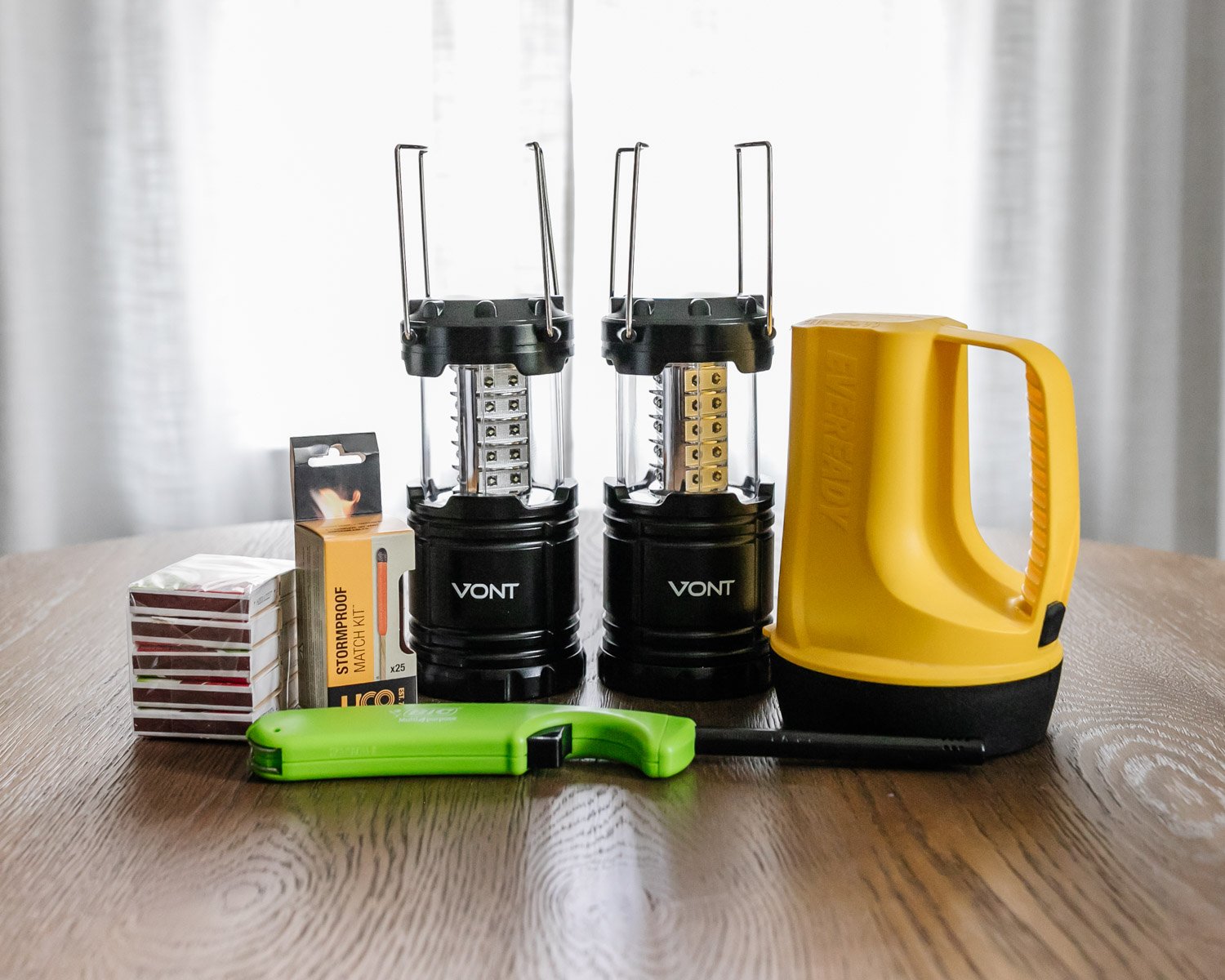
Heat and Light
We grab lights from our stash all the time when we have a power outage, so we’ve tested a lot over the years.
Waterproof Camping Lantern – This lantern has solar charging capability and up to 25 hours of runtime per charge. Plus, it can serve as an emergency backup charger for your phone.
Stormproof Match Kit – The waterproof case holds 25 windproof and waterproof matches. They will relight even after being submerged in water.
Insta-Fire Fire Starter – These make starting a fire easier with capability to start 120 fires in 30 packs.
BioLite CampStove – This wood burning camping stove generates electricity and has a built-in USB charger. Use it as a portable grill, coffee press, and kettle so you can boil water and cook meals. Twigs and pinecones can be used as fire fuel so power can remain plentiful.
3-in-1 Portable Grill and Fire Pit – This is a good, cheaper alternative to the BioLite CampStove. It won’t give you the capability to generate electricity, but it will make it easier to build a fire so you can boil water, keep warm, and have a cooking source.
Solar Powered Head Lamp – If you need to be hands-free, this head lamp is really handy. You don’t have to worry about stocking batteries since it has solar power charging capability.

Power and Communication
Even when I’m on the go on a daily basis, I always make sure I have a small backup charger in my purse. You just never know.
Solar Powered Phone Charger – Solar is the way to go when you need to keep your phone charged. This one also has a built-in flashlight.
Solar Generator – Gas-powered will likely have better performance, but when gasoline is scarce, this is the better bet to last beyond limited resources. If you prefer gas powered, this Honda generator is rated as one of the best out there.
Long Range Walkie Talkies – If someone in your group has to leave for a supply run or to go find help, it’s good to have these so you can still communicate while you’re apart.
Solar Hand Crank Radio – This NOAA weather alert radio has a built-in flashlight, USB output port, and SOS alarm.

Tools
A simple Swiss Army knife and some duct tape can go a long way in a disaster situation. This is what we keep on hand…
Survival Tool Kit – This has just about every little tool you’ll need. If you don’t want to get a kit, at least have a pocket knife handy.
Life Bivy – You can use this as a thermal sleeping bag or a tent. The entire pouch folds up to the size of a soda can. It comes with an emergency whistle, and the paracord can also be used as fire starter.
Gas Siphon Pump – After a disaster, if you find a gas source or a vehicle with fuel that is no longer drive-able, you can use this siphon kit to remove the fuel and use it where it’s most needed.
Storage Fuel Stabilizer – If you want to stockpile a few gallons of gasoline, it’s important to stabilize it. This gasoline treatment keeps fuel fresh for up to 24 months. Only use designated gas storage jugs, never other unapproved containers.
Other Items to Pack
- Document bag that’s fireproof and waterproof with all of your family’s important documents
- Cash in small bills
- Waterproof camping backpack
- Change of clothing, socks, and boots for each person (preferably waterproof tactical boots)
That was QUITE a list, but if that feels overwhelming, you can start small with just the basics (and add to your stash gradually).
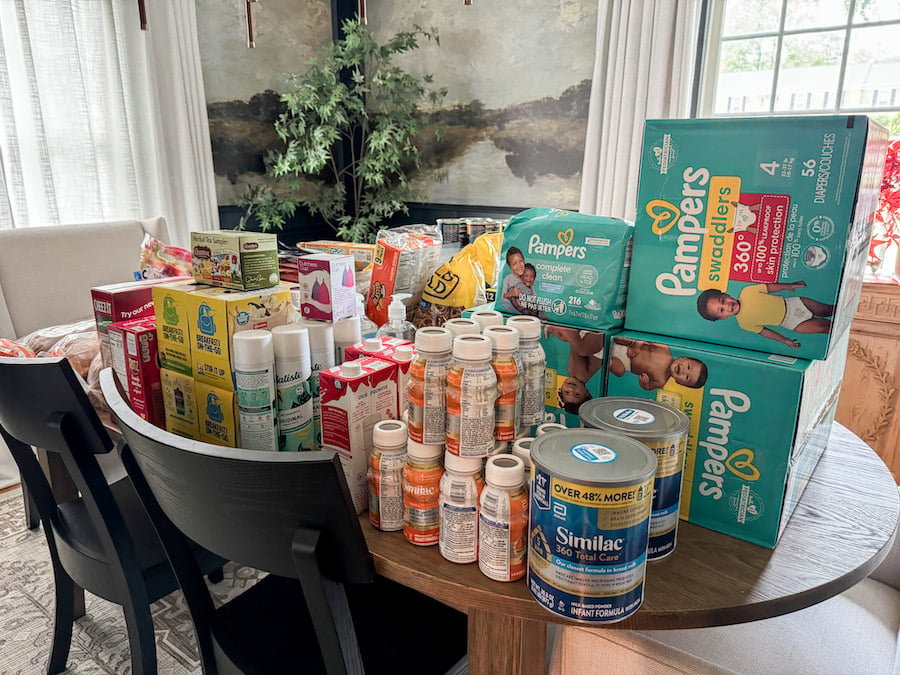
If I had to keep it to just the basics, I would stockpile these:
- Jugs of water – 1 gallon per person per day (for at least 3 days)
- LifeStraw water filter
- Enough non-perishable food for each person for 3 days
- Waterproof first aid kit (include prescription medications)
- Camping lanterns
- Solar power bank phone charger
- Hand sanitizer
- Wet wipes
- Solar hand crank weather radio
- Lighter and/or waterproof matches
- A tarp and duct tape
- A multitool
- Shoes, socks, and a change of clothing for everyone in your household
- A blanket for each person
- Cash in small bills
- Documents in a waterproof, fireproof bag
- A waterproof storage bin to keep it all in
I hope you never ever have to use these supplies, but maybe this list gives you some direction so you can have peace of mind if disaster ever strikes.
The worst feeling is knowing my kids are in harm’s way when we hear a hurricane is heading straight for us, but saying a prayer and having a home disaster kit is the best “mama bear protection” I can provide.
Is there anything you would add to this list?
More Home Tips to Help in Survival
How to Plant a Raised Bed Vegetable Garden with High Yield

The Best Wireless Lights from Amazon


The post What We Pack in Our Home Disaster Kit appeared first on Bless'er House.

